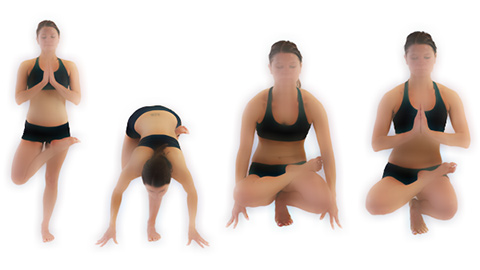
(created April 12, 2017, updated August 29, 2019)
Toe Stand is a finesse pose that requires a lot of strength to be able to do properly and gracefully.
Begin in Tree Pose with your hands in Namaskar. Optionally microbend the knee of the standing leg as you stretch your upper body forward, hands and fingertips moving forward, as you bend from your lower waist.
*** Place your fingertips on the ground for support, find your balance, breathe and pause. Bend the knee of the standing leg, lift up the heel of the standing leg, and sit down on the heel either in between your butt cheeks or placing the butt cheek that is the opposite side of the standing leg, breathe and pause. For example, if you are bending your left leg, you will sit your right butt cheek on top of the left heel.
Spider walk your fingers around your knees next to your hips, breathe and pause. Level your knees to your hips, breathe and pause. Straighten your head and spine to flatten your back. Find your balance again, breathe and pause.
Place your hands together in Namaskar. Smile and breathe. Don't forget to breathe! Pause and think about your name as you breathe in and think about your goddess as you breathe out.
The mistakes I see when I'm teaching this pose are:
- your head and/or upper body lean too far forward
- your knees are not at the same level
- your shoulders and hips are not in one line
- you don't suck your stomach in
- you rush to get your hands together in Namaskar towards the end
- you don't take time to move slowly into the posture, breathing every step of the way
- you keep looking at yourself in the mirror when you should be concentrating on finding your balance
- you keep comparing yourself to your classmates
- you give up too easily
|
|

|
Some things to try to improve this pose:
- maintain your balance throughout your pose by starting with a good Tree Pose and slowly moving into Toe Stand
- don't bite off more than you can chew; if you cannot sit on your heel, then work independently outside of your yoga classes to get to that point
- stand near a wall and use the wall to help you find your balance at every step of the pose
- you don't need to put your hands together in Namaskar; on some days, it's okay to use your fingertips for balance; over time, move from two hands to one hand to no hands for balance
- what I like to see at the end of the pose is an attempt at keeping the palms in Namaskar on the way up from sitting position; keep your hands as close to your body as possible, and come back into Tree; after Toe Stand, a teacher will sometimes tell you to acknowledge your hard work in the mirror, so your hands will be in the perfect position to do so
Touchless Toe (advanced version of this pose): Replace the *** step above by keeping your hands in prayer as you bend your knee to come down, placing your butt on your heel, never touching your hands on the floor. Find your balance and then extend your spine up leading with the top of your head. Those with some skill will keep their butt on their heel. Those with exceptional skill will continuously lift up and float their butt about an inch off of their heel. Slowly move into your final expression of the pose and give yourself various checkpoints to breathe before moving further. There is no need to rush into your final expression. Come out of the pose very slowly and confidently while keeping your hands in prayer.
This posture is a balancing pose and reveals a lot about your skeletal structure, stability, and your ability to maintain good alignment. The left and right halves of your body above your knees should look more or less symmetrical. The upper half of your body from head to lower back should be straight. Your entire body should be balancing on your heel, which you can think of as a really tiny chair.
Disclaimer: Before participating in this or any exercise program, please consult a physician. I make no express oral or written guarantees with this information. You will assume all responsibility and liability for any and all injuries you may sustain during your participation in yoga and the use of the information given here. This page will be continually updated, so be sure to check it again in the near future for new information. If you teach the Bikram series and would like to add to or contribute to these notes, feel free to contact me. |



